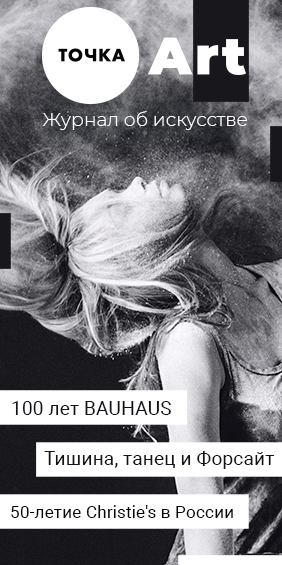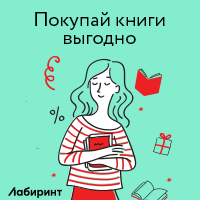The best regional museums of Russian art
ART Point magazine invites all the readers to travel through the museum provinces of our vast homeland. Museums of towns and villages of the Russian hinterland keep within their walls picturesque collections that are comparable in importance to the capital’s collections.
And while borders remain closed, all the art lovers are wondering where to go in Russia and which museums can already be visited, our magazine’s independent review lists 10 wonderful but little-known regional museums in Russia.
Khimki S. N. Gorshin Art Gallery
The gallery is based on a unique private collection of paintings and drawings of the XIX-XX centuries, donated by professor Sergey Gorshin. He is one of the largest collectors of Russian paintings, and a well-known scientist in the field of wood and forest protection, he is also the doctor of technical sciences and honored worker of science and technology.

Gorshin formed his collection for more than 50 years. In 1982, S. N. Gorshin presented two portraits of V. K. Byalynitsky (the authors of the portraits Bogdanov-Belsky and Zaitsev) to relatives of the artist who participated in the creation of the V. K. Byalynitsky-Birul Museum in Mogilev. And they, in turn, presented these portraits to the Museum. In 1989, the Tretyakov Gallery hosted an exhibition of paintings and drawings by artists of the second half of the XIX — first half of the XX centuries from the collection of S. N. Gorshin. More than 280 paintings and sketches were presented at the exhibition, 60 of them Gorshin presented to the Tretyakov Gallery. In the same year, Gorshin announced his intention to donate part of his collection to Khimki, and the Museum was officially opened in 1993: 203 paintings by 127 Russian artists from the Gorshin’s collection are still on exhibition at the Khimki Museum.
Of particular value to art and museums is the collection of works by famous masters of Russian painting of the XIX-XX centuries: I. K. Aivazovsky, L. F. Lagorio, K. E. Makovsky, V. D. Polenov, A. K. Savrasov, I. I. Shishkin, I. I. Levitan, I. S. Ostroukhov, K. A. Savitsky, S. V. Malyutin, V. N. Baksheev, S. Yu. Zhukovsky, P. I. Petrovichev, L. V. Turzhansky, A. S. Stepanov, N. P. Krymov, P. V. Kuznetsov, M. S. Saryan, Z. E. Serebryakova, M. A. Voloshin, D. D. Burlyuk, K. F. Yuon, R. R. Falk, S. A. Luchishkin, S. V. Gerasimov, and many others.
The Museum also presents the works of little-known and forgotten artists, such as K. I. Gorbatov, A.V. Isupov, I. A. Velts, A. A. Manevich, K. A. Veshilov, A. N. Benois, and A. E. Makovskaya, acquired by the collector in the 40-80s of the XX century. Among the Museum’s later collections are paintings by artists M. F. and M. M. Shemyakin, G. S. Myznikov, V. I. and A. I. Babin, and others.
In addition, the Museum’s collection includes a rich collection of gouaches, aquarelle, pastels and sketches by A. N. Benois, V. D. Polenov, Z. E. Serebryakova and also prints and book graphics.
Museum address: Moscow’ Oblast’, Khimki, Moskovskaya str., 15, 3rd floor.
Opening hours:
Monday — Wednesday from 11:00 to 18:00
Thursday from 11:00 to 20:00
Friday from 11:00 to 17:00
A.V. Grigoriev Art And History Museum, Kozmodemyansk
The A. V. Grigoriev Art And History Museum in Kozmodemyansk is one of the oldest art galleries on the Volga river. It was founded in 1919. As it is called by its’ museum workers — this is the «Small Tretyakov Gallery on the Volga».
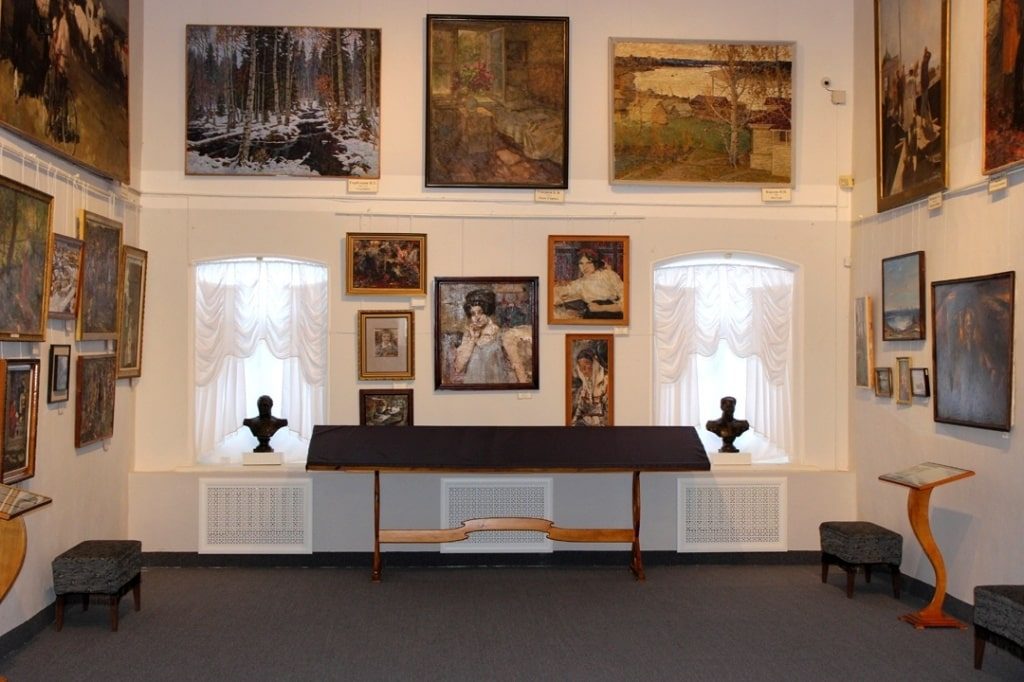
The Kozmodemyansk collection is based on the works of the Volga-Kama traveling exhibition, organized in 1918, which included paintings by Peredvizhniki and Kazan artists, in particular Pavel Radimov and Grigory Medvedev. The exhibition was planned to be shown in the cities of the Volga region and the Kama region, but the events of the Civil war intervened the plan: Kazan was cut off and occupied by the White Army. The artists who accompanied the exhibition, Pavel Radimov and Grigory Medvedev, were able to show exhibits only in Kozmodemyansk, where they stayed for the next two years. They went to the villages, painted the nature of the Gornomariysky region, the life of the Gornomariysk people. Pavel Radimov opened drawing courses in the village of Elasy and taught Gornomariysky people to draw.
Thus it turned out that the paintings of the Volga-Kama exhibition remained stored in Kozmodemyansk and formed the basis of the Museum, which was opened by Pavel Grigoriev on September 7, 1919. Today, the basis of this small provincial Museum is a collection of works by famous Russian artists of the second half of the XIX — early XX century: I. K. Aivazovsky, K. E. Makovsky, I. I. Tvorozhnikov, V. D. Polenov, K. A. Korovin, A. S. Stepanov, A. E. Arkhipov, Y. Y. Klever, P. P. Konchalovsky, K. F. Yuon. A special place in the collection is occupied by the works of N. I. Feshin. The Museum’s art collection is complemented by sculptures on ancient and biblical themes. In addition to a remarkable collection of paintings, the Museum houses collections of European porcelain, Chinese and Japanese ceramics.
Of particular importance for history and art which are kept in the Museum of the personal papers of A. V. Grigoriev. He dreamed with all his heart of seeing the «Little Tretyakov gallery» in his homeland: this is noticeable thanks to the letters found, autobiographies, greeting cards and telegrams, exhibition plans, invitation cards, reviews of museums, photographs of the artist. By the way, the Museum’s documentary archives are extremely interesting: they contain maps and plans of both the city of Kozmodemyansk separately, and the entire Kozmodemyansk district of the Kazan province. The Museum also contains drawings for the construction of stone chapels and churches in Kozmodemyansk and the district, materials on the history of the city and its streets collected by the oldest resident of the town V. P. Churakhin, as well as an album of pilot maps of the Sura, Vetluga and Volga rivers, and much more.
Museum address: 10 Likhacheva str., Kozmodemyansk, Mari El
Opening hours:
Tuesday — Sunday from 8:30 to 17:00
Monday is a day off
P. P. Chistyakov’s Museum
The unique Museum of Pavel Petrovich Chistyakov — an artist, teacher, Creator of his own pedagogical system, teacher of the largest masters of fine art of the late XIX-early XX centuries-is located in Tsarskoye Selo. The Friedental is the address of Pavel Petrovich Chistyakov, a Professor at the Imperial Academy of Arts, who owns the countrysite. Designed by architect A. H. Kolb in 1876-1877, it is a unique example of wooden architecture, a monument of country architecture of the last third of the XIX century.
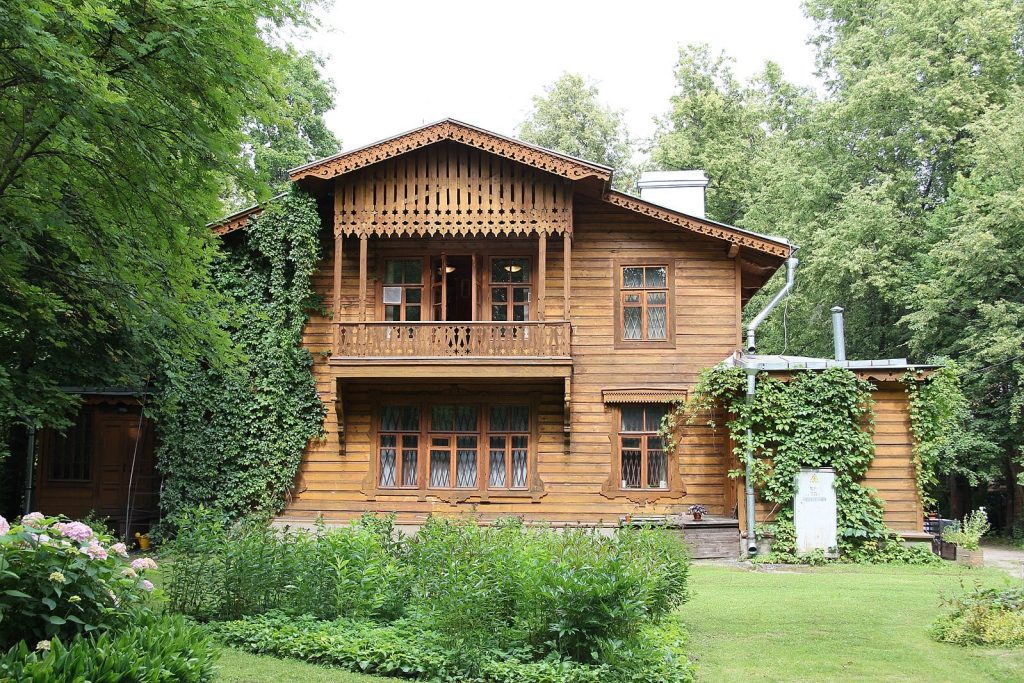
More than 40 years of Chistyakov’s life and work are closely connected with this house. The collection of the Pavel Petrovich Chistyakov Museum consists of original paintings and drawings, memorial and household items kept in the family of Chistyakov’s grandson, ya. V. Durdin, in the archive and Museum of the Academy of Arts. Acquaintance with the Museum begins in the garden, then continues in the house. The ground floor houses the exhibition on the construction of the house; also on the ground floor is familiar with the history of everyday life at home Chistyakova, with its inhabitants. The second floor is dedicated to the artist’s creative and educational activities. The old Grand piano still attracts music lovers to traditional evenings, as well as to the annual celebration of the birthday of the great teacher, this is the first Sunday in July. The corner (or small) living room regularly hosts exhibitions where contemporary artists present their paintings.
Museum address: 23 Moskovskoe shosse, Saint Petersburg
Opening hours:
Wednesdays, Saturdays and Sundays from 10:00 to 17:00
The Ivangorod Art Museum
The Ivangorod Museum was founded on may 30, 1980. It is located in the former merchant mansion of F. Y. Panteleev. The Museum houses an art gallery — the I. Y. Bilibin center for Graphic Arts. The permanent exhibition presents a unique collection of works by famous Russian graphic artists I. Y. Bilibin and A.V. Schtschekotichina-Potozkaya. The exhibition opens with an exhibition of folk costumes that Bilibin brought from ethnographic expeditions to The Russian North in 1902-1904.

From 1917 to 1919, Bilibin lived in the South, first in the Crimea, and then in Rostov-on-don. In February 1920, he went with the white army to Novorossiysk, from where he was evacuated on one of the ships to Egypt. In 1925, together with his wife Schtschekotichina-Potozkaya, he moved From Cairo to Paris, where he took part in the production of Russian operas as a theatre decorator. The Museum presents sketches of scenery for Rimsky-Korsakov’s Opera the Golden Cockerel and Mussorgsky’s Boris Godunov, staged in Paris in 1928 and 1930, respectively, as well as for Stravinsky’s ballet the Firebird, which Bilibin designed in 1931 for a production in Buenos Aires. On the second floor of the Museum there are paintings, sketches, models and household items, as well as a hall with porcelain of the Leningrad porcelain factory, where Schtschekotichina-Potozkaya worked since 1936, after returning to Russia.
The Museum also exhibits works by members of the World of Art Movement. International children’s drawing competitions are held, and works by local and foreign artists are exhibited.
Address of the Museum: Leningrad region, Ivangorod. 6\1 Kingisepp schosse
Opening hours:
Wednesday — Sunday from 10:00 to 18:00, ticket office until 17:30
Monday, Tuesday — closed
The museum is currently closed until further notice
F. A. Kovalenko Regional Art Museum, Krasnodar
The founder of the Krasnodar regional art Museum was a citizen of Ekaterinodar Fedor Akimovich Kovalenko. An avid art collector, he acquired paintings by Russian and Western European artists, and some works were given to the Museum as a gift from artists from the St. Petersburg Academy of Arts. From 1905 to 1916, twice a year, exhibitions were organised, which were attended by graduates of the Imperial Academy of arts, the Moscow School of Painting, sculpture and architecture, and later — artists from Kiev, Kharkiv, and Ekaterinodar.
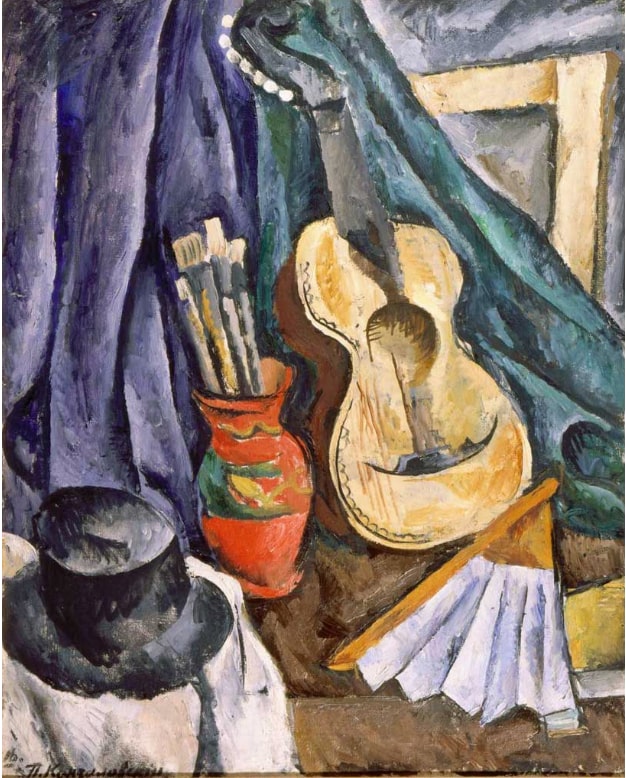
By the end of his life, the collection of F. A. Kovalenko consisted of 730 paintings, 1400 works of graphics, decorative and applied art.
Now the Museum has about 12,000 paintings, but the most interesting exhibition is the exhibition of Russian paintings, from icons to works of the XX century. The Museum is proud of its collection of avant — garde paintings-among the most famous artists are Kazimir Malevich, Vasily Kandinsky, Marc Chagall, Pavel Filonov, Natalia Goncharova, Mikhail Larionov, Olga Rozanova.
The avant-garde collection has been popular since the 1990s, and has since become increasingly famous. Some works took part in international exhibition projects (such as «The Great Utopia» — Germany, USA, 1992-1993; «Victory Over The Sun». International Biennale — France, 1993).
The Museum is also famous for its collection of Japanese color woodcuts of the XVIII — ser. XIX century. and the collection of Dutch art of the XVI century.
The Kovalenko Museum positions itself as the oldest in the North Caucasus, but keeping up with modern trends — the Museum halls are complemented by a virtual space with touch panels, and there is also an interactive book ’The Chronicles of Museum Life. Pages of history’.
Museum Adress: Krasnodar, Krasnaya str., 13
Opening hours:
Tuesday — Wednesday from 10:00 to 18:00, ticket office until 17:30
Thursday from 13:00 to 21:00, ticket office until 20:30
Friday — Sunday from 10:00 to 18:00, ticket office until 17:30
Monday is a day off
Memorial House Museum of K. S. Petrov-Vodkin, Khvalynsk
The memorial house-Museum of K. S. Petrov-Vodkin was opened in the artist’s homeland, in Khvalynsk, on November 4, 1995. The house, located in the southern part of the city, formerly called Bodrovka, where «blacksmiths and Mordvins engaged in latrine trade» settled, was built by the Khvalynsky blacksmith in 1896. Petrov-Vodkin bought this house in the summer of 1905 for his parents, with money received by the artist for the majolica panel «Dame And Child» for the facade of the Vreden Institute in St. Petersburg.
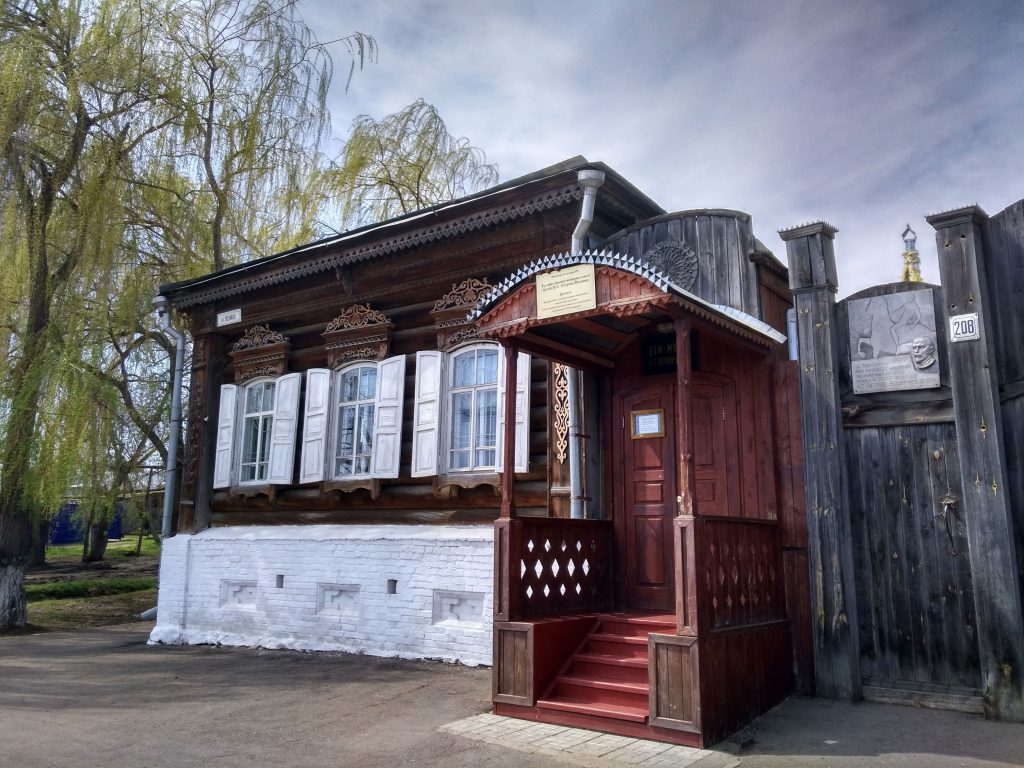
The house attracted the attention of Kuzma Sergeevich not by chance: it is illuminated by 15 Windows facing all sides of the world: throughout the day, the sun «travels around the house», alternately looking into the windows, which at that time had a magnificent view of the Volga, the Volga steppes, and the Khvalynsky gardens.
From 1905 to 1916, Petrov-Vodkin came to Khvalynsk almost every summer, not wanting to miss the opportunity to spend the summer at home. In this house, he worked on works that were included in the Golden Fund of Russian Art: «Bathing the red horse» (1912), «Mother» (1913), «Girls on the Volga» (1915), «Surroundings of Khvalynsk» (1909), «Fektya» (1916), «Noon, Summer» (1917). The hall, enclosed by an arch with Windows facing East and South, served as his workshop in summer, and in winter it became a wonderful garden with exotic plants of southern latitudes. The hall recreates the artist’s workshop and the winter garden that once were here. Petrov-Vodkin’s paintings are kept here: «self-Portrait», «Portrait of Mother» (1903), all the Volga sketches, palette and brushes of the artist.
The house recreates the atmosphere of family life in the late XIX — early XX centuries. In the exhibition, in addition to typological furniture, you can also see furniture that belonged to his parents. In the large dining room there is an authentic sideboard and a table where the artist’s mother wrote letters to her son during her life.
The Museum’s exposition is built in such a way that the photos and documents of the artist are «commented» by Petrov-Vodkin himself, who left many letters, autobiographical stories, and stories that made it possible to make the exhibition autobiographical.
After the revolution and during the Civil war, Petrov-Vodkin did not come to Khvalynsk, the last time he was here is 1923. The artist’s mother lived in this house until her death on March 11, 1941, outliving her son by two years. During the World War II, the wife and daughter of Kuzma Sergeevich, who were evacuated from Leningrad, lived here, and they sold the house in 1943. Having many owners, in 1990 the house was purchased by the city government to create a memorial museum of K. S. Petrov-Vodkin. After restoration (restoration of the previous layout of the house, stoves, release of walls from layers) the museum opened its’ doors to visitors in 1995.
Museum address: Saratov’ Oblast’, Khvalynsk, Lenin str., 89 (art gallery); 208
Opening hours:
Tuesday — Sunday from 9:00 to 17:00, ticket office until 16:00
Monday is a day off
A. N. Radishchev Art Museum, Saratov
One of the most significant provincial art museums in Russia was opened in 1885 and became the first publicly accessible art Museum in the Russian Empire. The exhibition is based on gifts to the Museum from the artist A. P. Bogolyubov, the grandson of A. N. Radishchev. The creation of the Museum for Alexey Petrovich Bogolyubov was a life’s work that required a lot of effort and money.
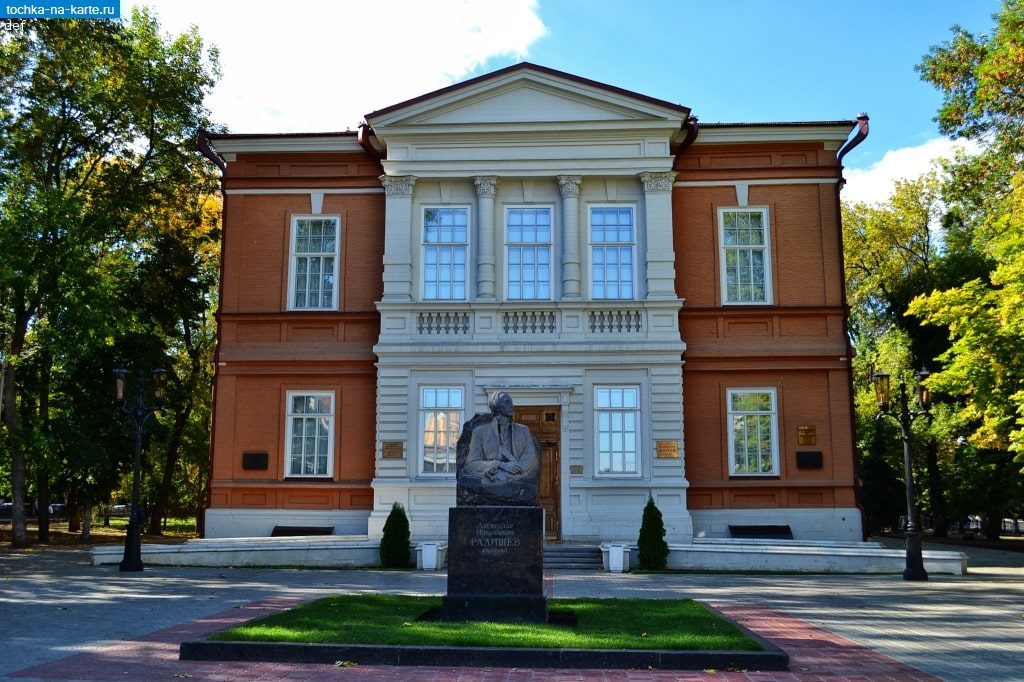
The Museum’s collection was supplemented by a number of exhibits transferred to the Museum from the St. Petersburg Academy of Arts and the Hermitage.
Among the most valuable works transferred from the Hermitage to the Museum in 1885 are the large canvas «the triumph of Bacchus» by Giorgio Vasari and the painting «John the Baptist» by the Flemish artist Theodore Rombouts.
By 1917, the Museum’s collections already contained 6,738 art objects: a collection of Russian and Western European paintings and sculptures, as well as large collections of furniture and applied art. The Museum’s library contained about 4,000 volumes of books.
Currently, the Radishchev Museum has a unique collection of Russian avant-garde, which includes about 200 works of painting, original and printed graphics, sculptures, and books. It was formed due to two main sources of income of exhibits: in the 1920s- from authors and from the Russian State Museum Fund, in the 1960s and 1970s — from the heirs of artists and private collectors.
The Museum’s collection includes works by the masters of the Jack of diamonds art Association — artists Vasily Kandinsky, Pyotr Konchalovsky, Ilya Mashkov, Aristarchus Lentulov, Robert Falk and Alexander Kuprin, whose work served as an impetus for the revision of the age-old traditions of fine art, which started the «epidemic of experimentation» that swept Russian painting in the 1910s. In addition, the Museum displays paintings by avant-garde artists Vladimir Tatlin, Kazimir Malevich, Alexander Shevchenko, members of the exhibition and publishing project Mikhail Larionov «Donkey’s tail», as well as paintings by Natalia Goncharova, Marc Chagall, Alexander Ekster and others.
Museum address: Saratov, Radishcheva str., 39
Opening hours:
Tuesday — Sunday from 10:00 to 18: 00, ticket office until 17:00
Thursday, Friday from 12:00 to 20:00, ticket office until 19:00
Monday is a day off
The Anna Golubkina Museum, Zaraisk
The memorial Museum of A. S. Golubkina, who is an outstanding Russian sculptor of the late XIX — early XX century, was opened in 1974. The Museum exhibition is located in the house that belonged to the Golubkin family, where Anna was born, lived and worked for many years, and died in 1927.
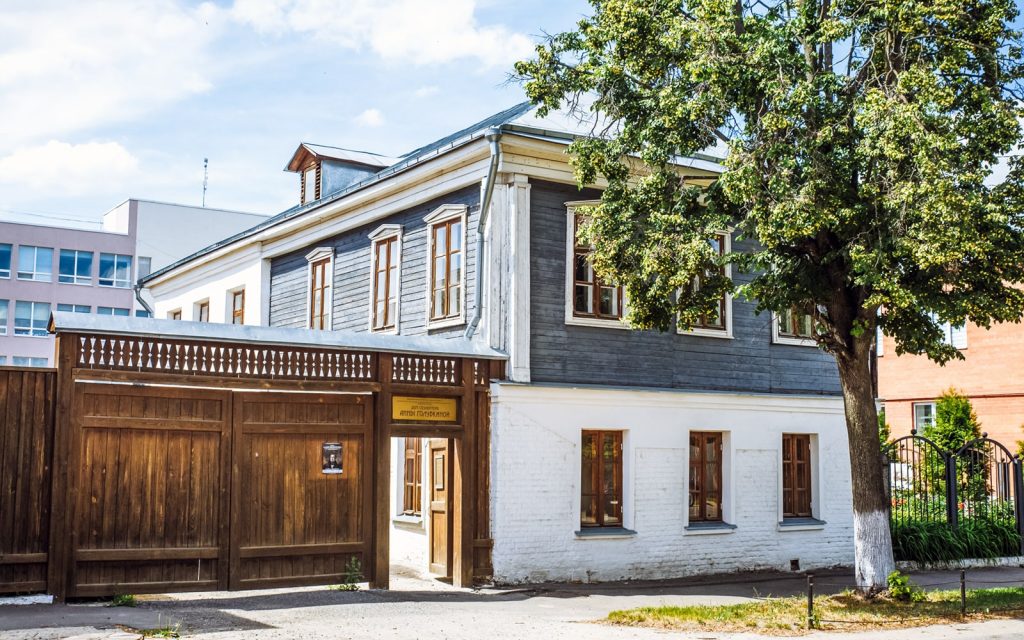
The exhibition includes personal items, copies of photographs and documents that tell about the life and creative path of the sculptor. The Museum’s collection consists of original photographs, letters, and works by Golubkina, including the «Fog» vase and the «Portrait of Emperor Alexander II». Copies of the sculptor’s works in the Museum give an idea of Golubkina’s art.
Museum address: 38 Dzerzhinskiy str., Zaraysk, Moscow region
Opening hours:
Tuesday — Sunday from 11:00 to 17:00
Monday is a day off
Samara Regional Art Museum
The Samara regional art Museum is one of the largest museums in the Russian province. This is the oldest and most prestigious exhibition venue in the Samara region. The Museum began its history in 1897, when an art Department was organised at the Samara Public Museum on the initiative of Samara artists led by Konstantin Golovkin, who donated their works after the exhibition. It also includes gifts sent by masters of Russian art (M. Nesterov, V. Baksheev) to Samara in response to Golovkin’s appeal through the press. After the revolution, the art Department’s collection began to grow due to works expropriated from private collections, including works from the State Museum Fund, the Hermitage, the Russian Museum, the Tretyakov gallery, the Saratov Radishchev Museum, and a number of other museums.
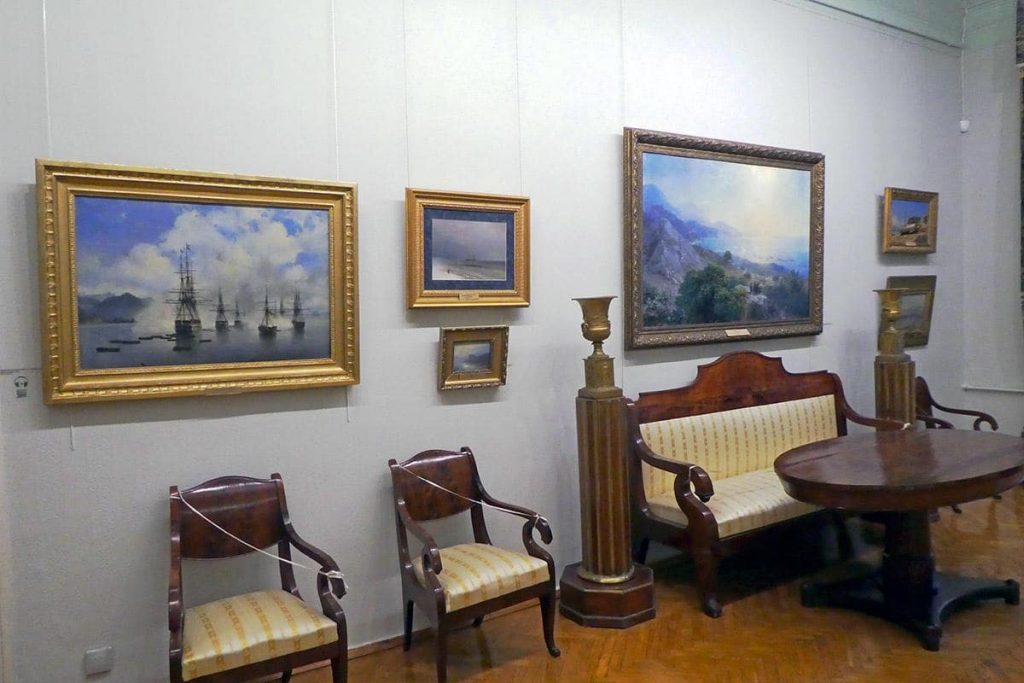
Currently, the Museum’s collection includes more than 350 thousand exhibits from the end of the XVI to the beginning of the XXI century. The pride of the Museum and the region is the works of masters of Russian art I. K. Aivazovsky, K. P. Bryullov, I. E. Repin, V. I. Surikov, I. I. Shishkin, A. I. Kuindzhi, I. I. Levitan, V. A. Serov, K. A. Korovin, K. S. Malevich, O. V. Rozanova.
One of the Museum’s branches is located in the village of Shiryaevo, closely associated with the life and work of Ilya Repin. While still a student at the St. Petersburg Academy of Arts, Repin, impressed by the scene of boatmen pulling a barge on the Neva river, conceived a painting dedicated to heavy boatmen’s labor. On the advice of a friend, the painter K. A. Savitsky, Ilya Efimovich, along with his younger brother Vasily and F.A. Vasiliev and E. K. Makarov in search of nature went along the Volga from Tver to Saratov. Once in the area of Zhiguli, they admired the beauty of the local places, they stopped and then moved closer to the goal of their journey — to the village of Shiryaev Buerak. The canvas «Boatmen on the Volga» written by the young Repin (1870-1873) was created on the basis of material collected during his stay in Shiryaev Buerak.
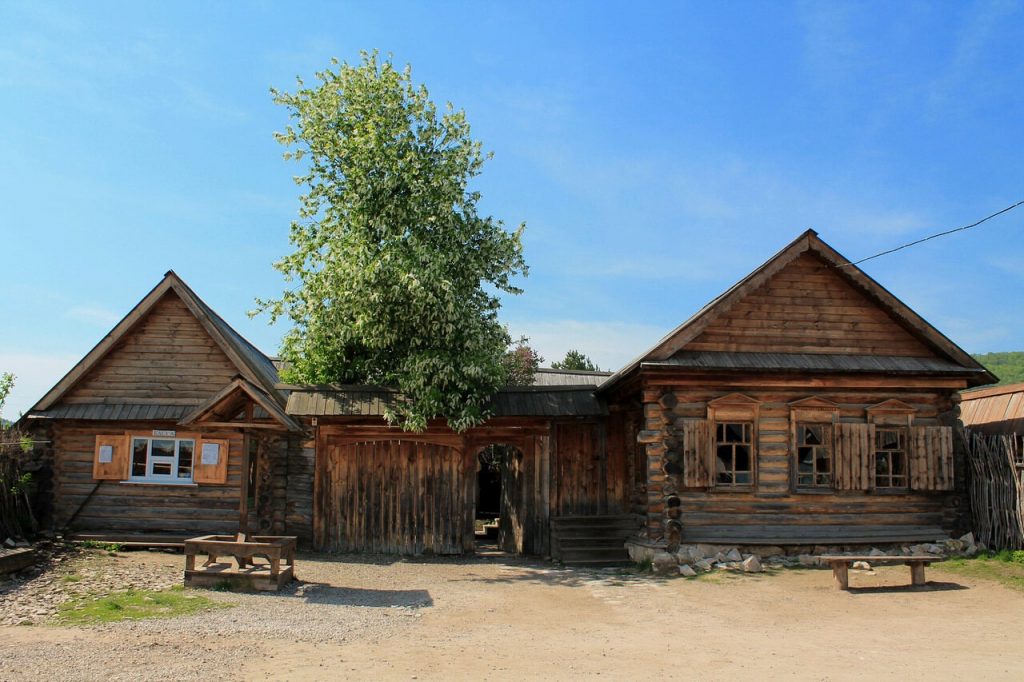
Currently, the Historical and Museum complex in the village of Shiryaevo includes three museums — the Museum of I. E. Repin (1850s), the Museum of the poet A. V. Shiryaevets (1890s), the estate of the merchant I.Vdovin (early XX сentury), and the recreational part.
Museum Adress: Samara, ul. Kuibysheva, 92
Opening hours:
Art Museum
Monday, Wednesday, Friday, Sunday from 10:00 to 18:00, ticket office until 17:30
Thursday, Saturday from 13:00 to 21:00, ticket office until 20:30
Tuesday is a day off
every second Monday of the month is a sanitary day.
Historical and Museum Complex in Shiryaevo
From October 1 to April 30:
Monday, Wednesday, Thursday, Friday, Saturday, Sunday from 8:30 to 17:00, ticket office until 16:30
Tuesday is a day off
From may 1 to September 30:
Monday, Wednesday, Friday, Sunday from 11:00 to 19:30, ticket office until 19:00
Thursday, Saturday from 11:30 to 20:00, ticket office until 19:30
Tuesday is a day off

